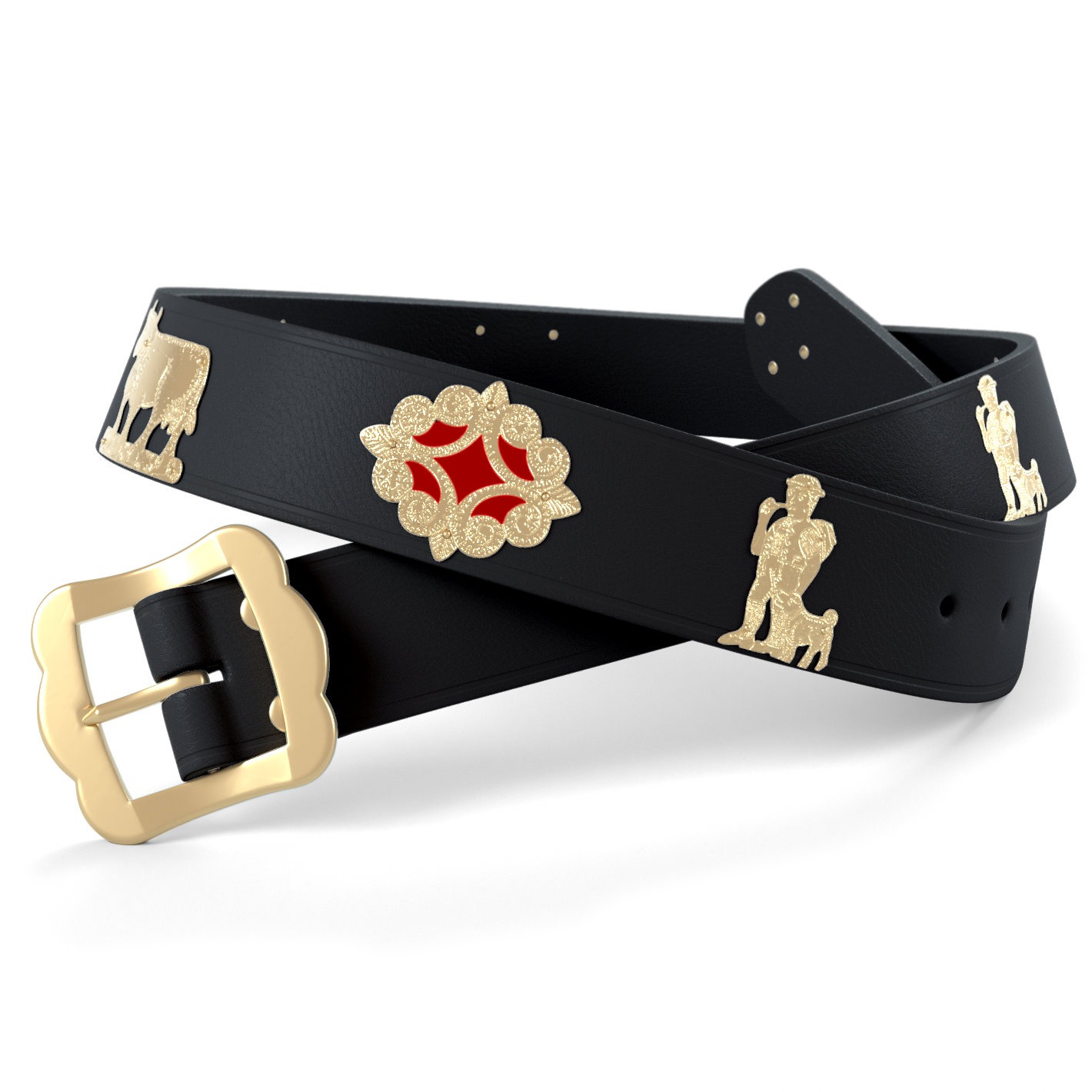| Weight | 220 g |
|---|---|
| Color | Black leather |
| Material Ornaments | Brass, nickel silver |
| Belt length | 60 cm (Hip circumference 50cm), 65 cm (Hip circumference 55cm), 70 cm (Hip circumference 60cm), 75 cm (Hip circumference 65cm), 80 cm (Hip circumference 70cm), 85 cm (Hip circumference 75cm) |
Appenzeller Kids belt (in stock)
CHF 71.23 - CHF 75.86
- Appenzell child belt in 3cm width
- With brass or nickel silver decorations and lace flower
- Made from black "Traceable Leather"
- Free delivery via A Mail within 3-5 days (CH), abroad + usual delivery times
- Stock according to specification
Kids belt in a different combination yourself? Click here for the configurator
Tips for measuring: The circumference measured at the height of the belt loop plus an additional 10 cm gives the correct belt length. Example: Circumference 60 cm plus 10 cm equals 70 cm. The optimum belt length in this case is 70 cm. We recommend buying the belts 5 cm larger so that it can be worn for longer.
Belt as a gift: An existing belts can also be measured: The length from the buckle to the most commonly used belt hole corresponds to Hip circumference, i.e. take this length and add 10cm, which gives the belt length.
Caution: Never measure the entire belts , as belts have belt ends of different lengths.
Belt sizes children
| Belt size | hip circumference |
|---|---|
| 60cm | 48-52cm |
| 65cm | 53-57cm |
| 70cm | 58-62cm |
| 75cm | 63-67cm |
| 80cm | 68-72cm |
| 85cm | 73-77cm |
Leather with a promising future
We use 100 percent sustainable cowhide, which we purchase through "Traceable Leather" sourcing. The animals have been treated with respect and have spent their lives on a regenerative, organic or other sustainable farm. "Traceable Leather" works with several small, locally active slaughterhouses in Germany and Switzerland as well as small farms.
The tanning is chrome-free and vegetable-based, carried out by a traditional company in southern Germany, so we can trace where and how the cow lived and how the tanning took place.
Ornament arrangement
Belt tip
Handicraft from Appenzellerland
The Appenzell belt is a piece of old Swiss tradition. The belts used to be made of handmade metal fittings showing Alpine motifs such as alpine dairymen, suns, ornaments and cows. The more ornaments there were on the belt, the richer the wearer was.
Today there are only a handful of producers left in Appenzell. Daniel Fuchs is one of the few and a third-generation saddler. Much has remained the same: The cutting of the leather, the arrangement of the elements, the ornaments are, however, only made by hand in individual cases. The brass and nickel silver ornaments are stamped, but always according to the respective pattern of the Sennensattler. They are thus the signature of the maker and the eye of the connoisseur recognises a Fuchs, Fässler or Bachmann.
Promising for the future
Leather
We use 100 percent sustainable cowhide, which we purchase through "Traceable Leather" sourcing. The animals have been treated with respect and have spent their lives on a regenerative, organic or other sustainable farm. "Traceable Leather" works with several small, locally active slaughterhouses in Germany and Switzerland, as well as small farms.
The tanning is chrome-free and vegetable-based, carried out by a traditional company in southern Germany, so we can trace where and how the cow lived and how the tanning took place.
Ornament arrangement
Belt tip
Handicraft from Appenzellerland
The Appenzell belt is a piece of old Swiss tradition. The belts used to be made of handmade metal fittings showing Alpine motifs such as alpine dairymen, suns, ornaments and cows. The more ornaments there were on the belt, the richer the wearer was.
Today there are only a handful of producers left in Appenzell. Daniel Fuchs is one of the few and a third-generation saddler. Much has remained the same: The cutting of the leather, the arrangement of the elements, the ornaments are, however, only made by hand in individual cases. The brass and nickel silver ornaments are stamped, but always according to the respective pattern of the Sennensattler. They are thus the signature of the maker and the eye of the connoisseur recognises a Fuchs, Fässler or Bachmann.



Bewertungen
Es gibt noch keine Bewertungen.